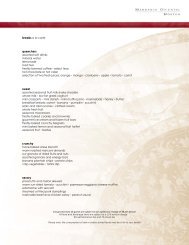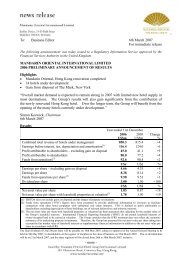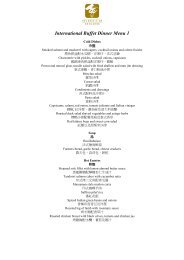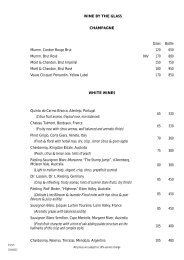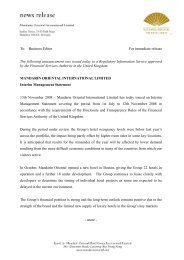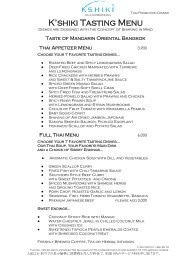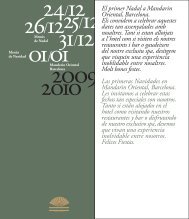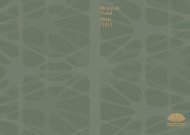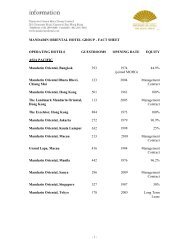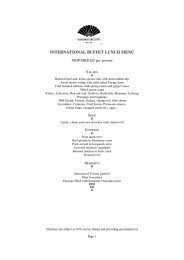Annual Report 2011 - Mandarin Oriental Hotel Group
Annual Report 2011 - Mandarin Oriental Hotel Group
Annual Report 2011 - Mandarin Oriental Hotel Group
You also want an ePaper? Increase the reach of your titles
YUMPU automatically turns print PDFs into web optimized ePapers that Google loves.
A Financial risk factors continued<br />
<strong>Annual</strong> <strong>Report</strong> <strong>2011</strong> 43<br />
i) Market risk continued<br />
Interest rate risk continued<br />
Cash flow interest rate risk is the risk that changes in market interest rates will impact cash flows arising from<br />
variable rate financial instruments. Borrowings at floating rates therefore expose the <strong>Group</strong> to cash flow interest<br />
rate risk. The <strong>Group</strong> manages this risk by using forward rate agreements to a maturity of one year, and by entering<br />
into interest rate swaps and caps for a maturity of up to seven years. Forward rate agreements and interest rate<br />
swaps have the economic effect of converting borrowings from floating rate to fixed rate, caps provide protection<br />
against a rise in floating rates above a pre-determined rate.<br />
At 31st December <strong>2011</strong>, if interest rates had been 100 basis points higher/lower with all other variables held<br />
constant, the <strong>Group</strong>’s profit after tax would have been US$1.2 million (2010: US$1.0 million) higher/lower,<br />
and hedging reserves would have been US$5.5 million (2010: US$7.0 million) higher/lower, as a result of fair<br />
value changes to cash flow hedges. The sensitivity analysis has been determined assuming that the change in<br />
interest rates had occurred at the balance sheet date and had been applied to the exposure to interest rate risk<br />
for both derivative and non-derivative financial instruments in existence at that date. There is no significant<br />
variation in the sensitivity analysis as a result of interest rate caps. The 100 basis point increase or decrease<br />
represents management’s assessment of a reasonably possible change in those interest rates which have the most<br />
impact on the <strong>Group</strong>, specifically the United States, Hong Kong and United Kingdom rates, over the period until<br />
the next annual balance sheet date. In the case of effective fair value hedges, changes in fair value of the hedged<br />
item caused by interest rate movements balance out in profit and loss against changes in the fair value of the<br />
hedging instruments. Changes in market interest rates affect the interest income or expense of non-derivative<br />
variable-interest financial instruments, the interest payments of which are not designated as hedged items of<br />
cash flow hedges against interest rate risks. As a consequence, they are included in the calculation of profit after<br />
tax sensitivities. Changes in the market interest rate of financial instruments that were designated as hedging<br />
instruments in a cash flow hedge to hedge payment fluctuations resulting from interest rate movements affect<br />
the hedging reserves and are therefore taken into consideration in the equity-related sensitivity calculations.<br />
ii) Credit risk<br />
The <strong>Group</strong>’s credit risk is primarily attributable to deposits with banks, credit exposures to customers and<br />
derivative financial instruments with a positive fair value. The <strong>Group</strong> has credit policies in place and the<br />
exposures to these credit risks are monitored on an ongoing basis.<br />
The <strong>Group</strong> manages its deposits with banks and financial institutions and transactions involving derivative<br />
financial instruments by monitoring credit ratings and capital adequacy ratios of counterparties, and limiting<br />
the aggregate risk to any individual counterparty. The utilization of credit limits is regularly monitored.<br />
At 31st December <strong>2011</strong>, 99% (2010: over 99%) of deposits and balances with banks and financial institutions<br />
were made to institutions with credit ratings of no less than A- (Fitch). Similarly transactions involving<br />
derivative financial instruments are with banks with sound credit ratings and capital adequacy ratios.<br />
At 31st December <strong>2011</strong>, there was no positive fair value of derivative financial instruments (2010: nil).<br />
Management does not expect any counterparty to fail to meet its obligations.<br />
In respect of credit exposures to customers and corporate companies, the <strong>Group</strong> has policies in place to ensure<br />
that sales on credit without collateral are made principally to travel agents and corporate companies with an<br />
appropriate credit history. Sales to other customers are made in cash or by major credit cards.<br />
The maximum exposure to credit risk is represented by the carrying amount of each financial asset in the balance<br />
sheet after deducting any impairment allowance.



